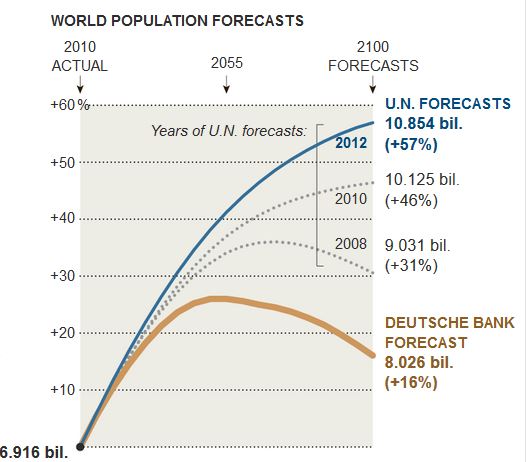There’s a good chance that if you’ve heard of Hans Rosling‘s name you are not as worried over population growth as the average person. If you haven’t, you are likely to think that the earth is being swarmed by people. The typical conundrum goes along the lines that we are overcrowding the planet with an ever increasing speed as if there was no tomorrow. Moreover, you probably believe that in order to prevent a global population bomb from exploding it is necessary to implement strict measures, such as the Chinese one child policy. When you look at the below graph it is difficult to disagree with such musings.
Fortunately, you would be wrong. Primarily because these issues are not that widely publicized and secondly because the dynamics of population growth can be rather counter intuitive.
Let us start from the beginning though.
“Population growth did not explode because people suddenly started breeding like rabbits; it’s just that they stopped dropping like flies”
For the best part of the existence of the homo sapiens our numbers remained in the ballpark of ten million. Although the hunter gatherers were probably healthier than the early farmers of the Neolithic age (they were as tall as people are today due to high protein diet) the predictable output of annual harvest proved to be a superior source of nutrition in the longer term. The efficiency boost also liberated human capacity for other purposes as I have talked in my previous posts. and helped human societies to develop into the complex interconnected systems they are today where only a fraction of the population is dedicated to the business of acquiring food and hunting and gathering are considered Bourgeoisie hobbies.
As you can see from the above graph, world population didn’t rise very fast after the onset of agriculture. It is because average human life was indeed “nasty, brutish and short“. Even as late as England in 1600 two thirds of children died before they reached the age of five. The ever present pestilence affected all levels of society – just think of the renowned economist David Ricardo, who died of ear infection at the age of 51 in 1823.
The breakthroughs that helped to end the horrendous levels of mortality took place in the fields of sanitation, medicine and food production. Other more random factors also contributed to this development. The first sector where the industrial revolution took off was the textile industry. With rapidly falling prices people could afford an extra pair of underwear which helped people to rid of some very common diseases related to intimate hygiene.
Population growth is actually declining
At first lower death rates did lead to a surge in population growth as you can clearly see from the graph – global population has multiplied 7-fold in just 200 years. However, lower death rates (especially lower child mortality) can in fact be a very positive thing from the point of view of population growth on top of the very obvious humanitarian benefits.
Hans Rosling has an ingenious website where anyone can play with the data on population. If you follow the links you can see yourself how child mortality has fallen over the past 200 years and how the fertility rate of women has dropped over the same period with increasing wealth being the common nominator. The point is that the higher chance children have to live the less children parents on average have. In fact women have globally an average of 2,5 children today compared to 5 only 50 years ago (in order for population levels to be stable the fertility rate has to be 2,1). The reason the world population is still growing is mainly because people are living to an ever older age and there are simply so many young people around.
There is also another factor that has a major impact on fertility rates – education of girls. More important that wealth (or draconian one child policies) is whether young girls stay in schools. For example, Iran and China managed to drive down their fertility rates over the same period of time with the former keeping its girls in schools and the latter pursuing its hugely disruptive (albeit effective) one child policy. The better educated the women of a society are the less of a problem rampant population growth is – a true win-win-scenario for any development policy.
In addition to having less and less children, men are apparently getting lucky less often these days. While this particular news might not be that significant factor in the grander scheme of things the undeniable fact is that population growth has been slowing down. Growth is slowing down both in relative terms (percentage added each year) since the 1960s and in absolute terms (actual number of people “added” each year) since the late 1980s. And the projections have to be adjusted almost on an annual basis in order to accommodate changes taking place.
Some estimates even predict that world population will peak and start declining during this century.
It remains to be seen but I am skeptical of such predictions as it is very difficult to estimate how we might start augmenting our physical limitations over the course of the course of the century (more on that later). I would argue that population growth is not really a problem but it could be. I was told some time ago that the first person to live a thousand years has already been born..


2 comments